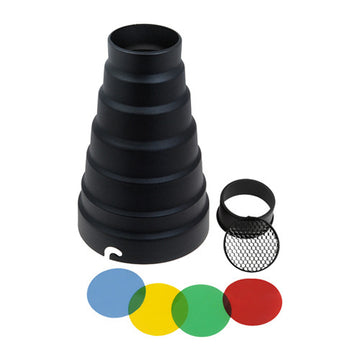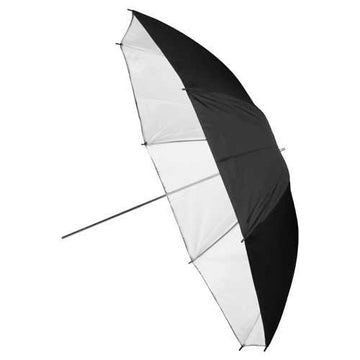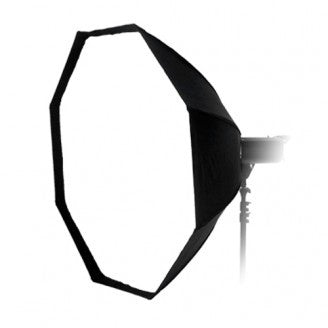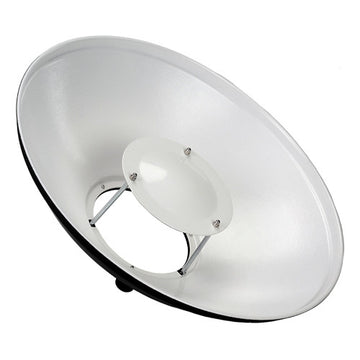The most basic element for creating photographs is light, without light the camera cannot expose an image. Light provides sharpness, details and colors for the camera to record an image, so it is extremely important to get the lighting correct so you can expose a proper image. In my experience there is no such thing as a perfect exposure, everything is subjective to the scene you are trying to capture and the 'look' you are going for, and even that is subjective to individual tastes. But good lighting is usually the difference between a good photo, and a bad one. Photography is all about playing with light and shadows. The way you illuminate your subject will decide your results.
So how do we get 'good' lighting, how do we change the lighting of a shot? With light modifiers! All flash lighting (strobe, led monolight, camera flash, etc) out of the box produces hard pinpoint light with harsh shadows which is generally unflattering. There are of course times where you may want this harsh light, but you will want to direct it in a way that it does the most good. In most cases though, you want to somehow soften and shape the light so it best suits your needs.
The world of light modifiers can seem intimidating and confusing with all the different types, shapes and sizes: Is a softbox better than an umbrella? Should I use a beauty dish or a snoot? Do I need a grid on any or all of these?? What the heck does parabolic mean?
The biggest question we get asked at Fotodiox (in regards to light modifiers) is: 'What should I get?'
The reply usually give is: 'It depends, what sort of look are you going for?'
It’s a more complicated question than it appears to be on the surface. Different modifiers will drastically change the look of the light falling on your subject and alter the look and feel of the shot. Do you want it to look like your subject is in a well-lit room? Perhaps a dark corner with just a slash of light coming in? Light modifiers are key to sculpting the look of your image and knowing what a modifier does and when or where to use it allows you to be a better photographer.
In this blog entry, we are going to look at an overview of the basic light modifier types you may come across and how they affect a single still life image. In future entries we'll go more in depth going into different sizes, options and subcategories of modifiers. But first, let’s get comfortable with knowing the main categories:
Reflectors / Snoots / Barn Doors
Used to 'shape' light direction or spill

PROS: Pin-point light-shaping abilities without diffusion, some pretty affordable options
CONS: Unless otherwise diffused, it leaves the light output harsh & bare
USES: Main fill light or small accents (hair, rim lighting, etc.), depending on how it’s used. Crafting high or low-key images
 |
7" White Interior Reflector on Fotodiox LED-100WB LED Light
f/4 @ 1/125s - Nikon D810, ISO-800 |
There are cases when you may want to shoot with a bare bulb, or just the bare strobe light with some light shaping to avoid spill but no diffusion or bounce to it. You may want to blow the highlights to a certain extent by getting the most light from the source at its power rating. This can create a high key result in the image, bringing out light tones and whites. At times the effect may look somewhat overexposed on the histogram, but this is fine so long as the subject is not overexposed.
A hard light source produces hard shadows with minimal transition between the light and dark areas of the image. Hard light is often (but not always) associated with creating deeper, darker shadows. Hard light gets a bad rep as its often used incorrectly. For example, hard light will create dark shadows under the eyes in a portrait. But it tends to create more contrast in an image and can be combined with the position of the light source to avoid shadowy eyes and create drama inside a portrait.
Umbrellas
Collapsible, different varieties, can be hand-held or on a light stand

PROS: Cheap, fast, and great soft light source this is relatively efficient
CONS: Metal ribs on umbrellas can break easily. Very little control over directionality and spill
USES: Quick and dirty simple lighting setups where you need to quickly set up 1-2 lights
 |
43" Silver Reflective Umbrella on Fotodiox LED-100WB LED Light
f/4 @ 1/40s - Nikon D810, ISO-800 |
Umbrellas create a spread of light that is soft, abundant, and very forgiving. They are great if you want to light a large area with flat even lighting. Because umbrellas are quite easy to use, and relatively inexpensive, they are ideal as your first light modifier. On the downside, umbrellas will over-light your shot spreading the light around. Lots of light. Everywhere. Much like learning how to ride a bike using training wheels. Use them as a learning tool until you get your balance, then move on to a better bike.
The umbrella is a common light modifier that is shaped and opens/closes just like an umbrella you would use on rainy days. The light source can also be placed to shoot directly through the umbrella as a diffuser, or it can be placed to bounce diffused light back to the subject, providing a softer light that can cover a large area that is under the umbrella. Broad lighting coverage is ideal for full body fashion shots or group shots. A softbox may not provide enough light while a beauty dish could be too harsh; an umbrella provides great lighting for groups since it can diffuse light to a large area.
Note: Umbrellas are perfect for indoor lighting but can become tricky, sometimes downright dangerous, to use outside. Many photographers have had expensive lights blown over when using umbrellas as they can catch the wind. If you must use them outside, please make sure you have somebody holding them or many sandbags on your light stands to keep them in place.
Softboxes
Collapsible, multiple variants, needs light stand.
Ranges from super cheap to very expensive.

PROS: Great balance of portability and light control, doesn’t spill everywhere, easier to get directional light (especially with a grid)
CONS: Some options can be rather pricey. Setup time can take up to 5 mins per softbox and take some effort to build
USES: A softbox is great for shooting a single subject, a couple, or an entire family, either in-studio or on-location. Add a grid to the softbox, if you’re in a setting where you want to minimize spill on foreground / background.
 |
48" Octagon EZ-Pro Softbox on Fotodiox LED-100WB LED Light
f/4 @ 1/40s - Nikon D810, ISO-800 |
This is a versatile modifier that creates a beautiful soft light source you can easily control. If I could only pick one light modifier to take to a deserted island, it would have to be the softbox. Small, medium, or large – softboxes are my go-to light modifier for the majority of my shoots. Why? The quality of light is flattering and malleable. Changing the angle and distance of the softbox to the subject easily changes the brightness, hardness and direction of the light.
Softboxes diffuse the light evenly on the subject, providing the feel of soft daylight through a window. Softer light is also more flattering for portraits since it gives a more pleasing look to the subject, ideal for beauty and headshots. I think what I like most about this light modifier is that it’s subtle. Highlights gently merge to shadows. I use a few different kinds of softboxes depending on where and what I’m shooting.
Some photographers remove the interior diffusion panel because they like having more contrast of the harder light (ie: not as diffused), but it really depends on what look you want for your subject. Silver interior panels increase the spread and contrast of your light more than white interior softboxes.

One variant of the standard softbox is the deep softbox (often times called a parabolic); which is a deeper cone-like shape that bounces the light differently. These variants yield more focused light (narrower light spread) with less spray; the increased distance from light source to front diffusion panel produces a more diffused light with less rapid falloff, more even coverage and less of a hot spot.
 |
48"in" Octagon Deep EZ-Pro Softbox on Fotodiox LED-100WB LED Light
f/4 @ 1/30s - Nikon D810, ISO-800 |
Beauty Dishes
Solid construction (does not collapse!), needs a light stand

PROS: Harder, yet highly controllable quality of light, thanks to the bounce plate and grid accessory
CONS: Many do not collapse, require a lot of power, often rather expensive when buying a complete system with a grid
USES: Anything from general portraiture to high-end fashion work. Very good at keeping light focused on subject, allowing you to shoot a complex scene with ease.
 |
22" Beauty Dish on Fotodiox LED-100WB LED Light
f/4 @ 1/40s - Nikon D810, ISO-800 |
A metallic parabolic dish that bounces light from the strobe to the subject in a distinct circular shape providing a soft yet contrasting light while boosting highlights and details. Dishes are ideal for lighting faces and defining bone structure such as cheek bones and chin lines. They tend to be used mostly for product or beauty shots. The light bounces from a smaller plate that covers the light head into the rest of the dish, which due to the curvature of the dish, bounces the light toward the subject. As you may suspect, the larger the diameter, the more light the dish can bounce.
While softboxes are excellent for soft beautiful light; the beauty dish is needed when details in color, skin tone and texture are required. When shooting for models or products that need to showcase these features, the beauty dish provides better light on the subject. They also create a circular catch light in your model’s eyes, which makes the reflection seem quite natural. As you can imagine, this makes these modifiers popular with fashion/beauty and celebrity photographers.
The downside of using beauty dishes is that the fall-off, from light to dark, is very rapid so you’ll often get shadows under your model’s chin and nose. You can compensate for the shadows by adding a white reflector, to reflect light up onto your subject’s face.
In the real world of photography, different combinations of lights and light modifiers are used. Along with different options for each modifier; inner diffusion panel taken off but grid added, colored gel with diffusion but no grid, etc. Sometimes a single key light is enough to shoot with. Other times, like when shooting an editorial, different types of lighting systems and modifiers are used to produce the best image. The creative vision of the photographer or director really directs what lights and modifiers are needed. There is no absolute way of doing it so there is freedom to explore what works best for the photographer.

Keep a lookout for future articles in the Light Modifier series which will go more in depth on the various types, sizes, options and more. Happy shooting!












